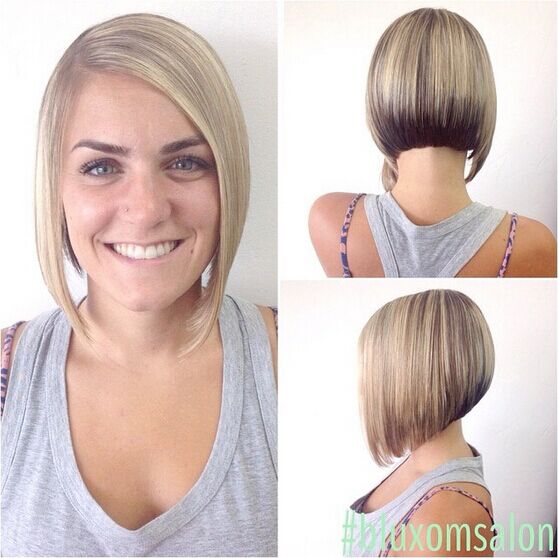 Most Trendy Bob Hairstyles 20142015 WardrobeLooks.comhttp://wardrobelooks.com/wp-content/uploads/2014/04/Most-Trendy-Bob-Hairstyles-2014-2015-8.jpg
Most Trendy Bob Hairstyles 20142015 WardrobeLooks.comhttp://wardrobelooks.com/wp-content/uploads/2014/04/Most-Trendy-Bob-Hairstyles-2014-2015-8.jpg
Bob Hairstyles Haircuts
A hair, hairdo, or haircut refers to the styling of mane, usually on the real human head. Sometimes, this could indicate an editing of beard scalp also. The fashioning of hair can be viewed as an element of personal grooming, fashion, and cosmetics, although practical, cultural, and popular factors influence some hairstyles also. The oldest known depiction of hair braiding dates back about 30,000 years. In early civilizations, women's scalp was often elaborately and carefully dressed in special ways. In Imperial Rome, women used their hair in complicated styles. From the time of the Roman Empire[citation needed] before Middle Ages, the majority of females grew their locks as long as it would obviously grow. Through the Roman Empire as well as in the 16th century in the western world, women started out to wear their hair in ornate styles extremely. Within the later half of the 15th century and on in to the 16th century an extremely high hairline on the forehead was considered attractive. Through the 15th and 16th centuries, Western men wore their mane cropped no than shoulder-length longer. In the early 17th century male hairstyles grew longer, with waves or curls being considered desirable.
The male wig was pioneered by Ruler Louis XIII of France (1601-1643) in 1624. Perukes or periwigs for men were created into the English-speaking world with other French styles in 1660. 17th-century wigs were lengthy and wavy late, but became shorter in the mid-18th century, by which time they were white normally. Short hair for fashionable men was a product of the Neoclassical movement. In the first 19th hundred years the man beard, and moustaches and sideburns also, made a solid reappearance. In the 16th to the 19th century, European women's scalp became more noticeable while their scalp coverings grew smaller. In the center of the 18th hundred years the pouf style developed. During the First World Conflict, women around the world started to shift to shorter hairstyles that were simpler to manage. In the first 1950s women's hair was generally curled and worn in a variety of styles and lengths. In the 1960s, a lot of women started to wear their scalp in short modern cuts such as the pixie cut, while in the 1970s, mane tended to looser be longer and. In both the 1960s and 1970s many men and women used their locks very direct and long. In the 1980s, women pulled back their hair with scrunchies. Through the 1980s, punk hairstyles were implemented by some sociable people.
Throughout times, folks have worn their mane in a multitude of styles, largely determined by the fashions of the culture they live in. Hairstyles are signifiers and markers of social class, age, marital status, racial identification, political beliefs, and attitudes about gender.
In many cultures, for religious reasons often, women's wild hair is protected while in public areas, and in a few, such as Haredi Judaism or Western european Orthodox communities, women's mane is shaved or trim very brief, and protected with wigs.Only since the end of World War I've women started to wear their mane brief and in reasonably natural styles.
Paleolithic
- The oldest known duplication of mane braiding lies again about 30,000 years: the Venus of Willendorf, now known in academia as the girl of Willendorf, of a lady figurine from the Paleolithic, estimated to obtain been made between about 28,000 and 25,000 BCE.The Venus of Brassempouy matters about 25,000 years of age and shows hairstyling indisputably.
Bronze Age
- In Bronze Get older razors were known and used by some men, but not on a daily basis since the method was rather upsetting and required resharpening of the tool which reduced its stamina.
Ancient history
- In old civilizations, women's scalp was often elaborately and carefully dressed up in special ways. Women colored their wild hair, curled it, and pinned it up (ponytail) in many ways. They established their hair in waves and curls using wet clay, that they dried in sunlight and then combed out, if not by utilizing a jelly manufactured from quince seeds soaked in normal water, or styling tongs and styling irons of varied kinds.
Roman Empire and Middle Ages
- Between 27 BC and 102 Advertisement, in Imperial Rome, women wore their locks in complicated styles: scores of curls on top, or in rows of waves, drawn back to braids or ringlets. Eventually noblewomen's hairstyles grew so complex that they required daily attention from several slaves and a stylist in order to be maintained. The mane was lightened using timber ash, unslaked lime and sodium bicarbonate, or darkened with copper filings, oak-apples or leeches marinated in wines and vinegar. It was augmented by wigs, hairpieces and pads, and held set up by nets, pins, pomade and combs. Beneath the Byzantine Empire, noblewomen covered almost all of their hair with silk caps and pearl nets.
Best HAIRSTYLES For Short Hair Women
- It is very important to find the best short hair styles for women since it takes on a huge part of your style. Getting the right hairstyle can offer you with enjoyment and positive emotions. Find out which hairstyle is ideal for your personality and character. You should also check with your hairstylist before having a new haircut. After all, changes are excellent and it can also add positive outlook in your life. Feel absolve to browse our collection of short hairstyles for ladies and choose the the one which your like best.
Best Angled Bob Hairstyles 20122013 Pictures
 http://thebestfashionblog.com/wp-content/uploads/2012/03/Angled-Bob-Hairstyles-2012-2013-Pictures-5.jpg
http://thebestfashionblog.com/wp-content/uploads/2012/03/Angled-Bob-Hairstyles-2012-2013-Pictures-5.jpgBest Angled Bob Hairstyles 20122013 Pictures
 http://thebestfashionblog.com/wp-content/uploads/2012/03/Angled-Bob-Hairstyles-2012-2013-Pictures-5.jpg
http://thebestfashionblog.com/wp-content/uploads/2012/03/Angled-Bob-Hairstyles-2012-2013-Pictures-5.jpg22 Popular Bob Haircuts for Short Hair Pretty Designs
 http://www.prettydesigns.com/wp-content/uploads/2015/06/Inverted-Bob-Hairstyle-for-Women.jpg
http://www.prettydesigns.com/wp-content/uploads/2015/06/Inverted-Bob-Hairstyle-for-Women.jpglong bob haircuts long bob hairstyles
 https://blogger.googleusercontent.com/img/b/R29vZ2xl/AVvXsEjiwBxfE2N665DQmK6SO7VguavyNVCYYYTGq0Y_7uaMLNkmWBTrhDUvSTZ6DCmf9EXI6lTqCHYiMTqVYIQ1icBJ_8f8JnWcRrVExqSO_0C3-K8O01ephbd3eRuni6TBE_YL36GokpkVD6A/s1600/Long_Bob_Hairstyle_5.jpg
https://blogger.googleusercontent.com/img/b/R29vZ2xl/AVvXsEjiwBxfE2N665DQmK6SO7VguavyNVCYYYTGq0Y_7uaMLNkmWBTrhDUvSTZ6DCmf9EXI6lTqCHYiMTqVYIQ1icBJ_8f8JnWcRrVExqSO_0C3-K8O01ephbd3eRuni6TBE_YL36GokpkVD6A/s1600/Long_Bob_Hairstyle_5.jpgOIP.M98fb7766ea5b58c11f16e61269af5529o1
40660D1784867DEA55B4AEB1AA2D2190CCBE99AA3Bhttp://wardrobelooks.com/most-trendy-bob-hairstyles-2014-2015/
Embed Our image to your website
ThumbnailImageEmbed Our image to a Forum
ThumbnailImage








.jpg)
.jpg)

